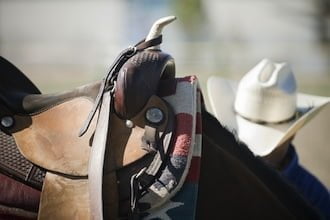For those who have yet to explore the world of Western riding, here’s a little more about what to expect, some of the differences between English and Western, and for the fashionistas, what to wear!
A couple of things to remember before you mount up:
- You can’t adjust the stirrup length from in the saddle like you can in an English saddle; it is better to get it right before you mount

- The girth (called a cinch in Western riding) also needs to be tight enough before you mount
- The pommel, or saddle horn, is much larger than we are used to
- The reins are generally split
- To dismount, Western riders generally stand up in the stirrups, swing the right leg over and step down, with the left foot in the stirrup.
Sensitivity and schooling
A major concern for most English riders is the severity of the Western bits in comparison to our traditional snaffles. The biggest difference for Western riding is that the reins are not ridden with a ‘contact’ or feel on the mouth. Western aids come from the seat. A well-schooled Western horse is supremely light to the aids.
Riding position
The Western saddle also places the rider in a slightly different position to that which we are used to. Dressage riders may well find it easier than showjumpers do. Some riders may find that their leg is ahead of the position that they are used to sitting in. The Western saddle has a broader seat and so gives wonderful stability to a rider.
Western rider wear
- Hat: A wide-brimmed hat with a crease in the top that sits securely so that it doesn’t blow off Riders under 18 must wear a safety helmet
- Shirt: Long-sleeved shirt, with a collar and cuffs
- Tie: Most often a string/bolo tie
- Jeans: Jeans or riding pants with a boot leg
- Boots: Neat leather boots with Western-style heel or flat heel
Optional
- Gloves: Traditionally made from chamois, but any neat glove is acceptable
- Chaps: Functional or ornamental allowed
- Belt and buckle: Ornate or simple
- Waistcoat: May be worn over long-sleeved shirt
- Spurs and spur straps: Round or blunt rowel Western-style spurs allowed
- Cuffs:Leather sleeve cuff covers or ornate cufflinks are acceptable
Training tips
An English-trained horse will have to learn to neck rein, jog, lope at the lower levels and perform roll backs, spins and sliding stops at the higher levels, depending on the level of competition that is entered. Leg aids and weight aids are used as well. Some adjustment and refinement may be required depending on the sensitivity and competency of horse and rider.
Gaits
- Jog – is very smooth, relaxed and slightly faster than a walk.
- Lope – the Western lope is a slow, relaxed canter.
Disciplines
Western classes comprise three different disciplines: Western pleasure, Western performance and reining. Each category has its own requirements and it is best to get advice from a qualified trainer as to which category best suits you and your horse.
 Tack – the ideal setup
Tack – the ideal setup
- Western saddle
- Western-style headstall (bridle)
- Legal curb bit
- Split reins
- Saddle pad
- If you use a back cinch, a cinch connector is compulsory.
Text: Mandy Schröder, Photography: Shutterstock
The full article appears in the March 2015 issue (97) of HQ.


